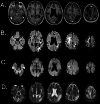The stroke outcome optimization project: Acute ischemic strokes from a comprehensive stroke center
- PMID: 39095364
- PMCID: PMC11297183
- DOI: 10.1038/s41597-024-03667-5
The stroke outcome optimization project: Acute ischemic strokes from a comprehensive stroke center
Abstract
Stroke is a leading cause of disability, and Magnetic Resonance Imaging (MRI) is routinely acquired for acute stroke management. Publicly sharing these datasets can aid in the development of machine learning algorithms, particularly for lesion identification, brain health quantification, and prognosis. These algorithms thrive on large amounts of information, but require diverse datasets to avoid overfitting to specific populations or acquisitions. While there are many large public MRI datasets, few of these include acute stroke. We describe clinical MRI using diffusion-weighted, fluid-attenuated and T1-weighted modalities for 1715 individuals admitted in the upstate of South Carolina, of whom 1461 have acute ischemic stroke. Demographic and impairment data are provided for 1106 of the stroke survivors from this cohort. Our validation demonstrates that machine learning can leverage the imaging data to predict stroke severity as measured by the NIH Stroke Scale/Score (NIHSS). We share not only the raw data, but also the scripts for replicating our findings. These tools can aid in education, and provide a benchmark for validating improved methods.
© 2024. The Author(s).
Conflict of interest statement
The authors declare no competing interests.
Figures




Similar articles
-
Big Data Approaches to Phenotyping Acute Ischemic Stroke Using Automated Lesion Segmentation of Multi-Center Magnetic Resonance Imaging Data.Stroke. 2019 Jul;50(7):1734-1741. doi: 10.1161/STROKEAHA.119.025373. Epub 2019 Jun 10. Stroke. 2019. PMID: 31177973 Free PMC article.
-
Localized prediction of tissue outcome in acute ischemic stroke patients using diffusion- and perfusion-weighted MRI datasets.PLoS One. 2020 Nov 5;15(11):e0241917. doi: 10.1371/journal.pone.0241917. eCollection 2020. PLoS One. 2020. PMID: 33152045 Free PMC article.
-
Amide Proton Transfer-Weighted MRI, Associations with Clinical Severity and Prognosis in Ischemic Strokes.J Magn Reson Imaging. 2024 Dec;60(6):2509-2517. doi: 10.1002/jmri.29333. Epub 2024 Mar 1. J Magn Reson Imaging. 2024. PMID: 38426606
-
Deep learning models for ischemic stroke lesion segmentation in medical images: A survey.Comput Biol Med. 2024 Jun;175:108509. doi: 10.1016/j.compbiomed.2024.108509. Epub 2024 Apr 25. Comput Biol Med. 2024. PMID: 38677171 Review.
-
Non-Contrast MRI Sequences for Ischemic Stroke: A Concise Overview for Clinical Radiologists.Vasc Health Risk Manag. 2024 Nov 26;20:521-531. doi: 10.2147/VHRM.S474143. eCollection 2024. Vasc Health Risk Manag. 2024. PMID: 39618686 Free PMC article. Review.
Cited by
-
A foundation model for generalized brain MRI analysis.medRxiv [Preprint]. 2024 Dec 3:2024.12.02.24317992. doi: 10.1101/2024.12.02.24317992. medRxiv. 2024. PMID: 39677480 Free PMC article. Preprint.
-
An approach to building foundation models for brain image analysis.Med Image Comput Comput Assist Interv. 2024 Oct;15012:421-431. doi: 10.1007/978-3-031-72390-2_40. Epub 2024 Oct 23. Med Image Comput Comput Assist Interv. 2024. PMID: 40290346 Free PMC article.
-
From MRIcro to MRIcron: The evolution of neuroimaging visualization tools.Neuropsychologia. 2025 Jan 29;207:109067. doi: 10.1016/j.neuropsychologia.2025.109067. Epub 2025 Jan 4. Neuropsychologia. 2025. PMID: 39761848 Free PMC article.
References
-
- Writing Group Members. et al. Heart Disease and Stroke Statistics-2016 Update: A Report From the American Heart Association. Circulation133, e38–360 (2016). - PubMed
Publication types
MeSH terms
Grants and funding
- P50 DC014664/DC/NIDCD NIH HHS/United States
- RF1 MH133701/MH/NIMH NIH HHS/United States
- RF1MH133701/U.S. Department of Health & Human Services | NIH | National Institute of Mental Health (NIMH)
- P50DC014664/U.S. Department of Health & Human Services | NIH | National Institute on Deafness and Other Communication Disorders (NIDCD)
LinkOut - more resources
Full Text Sources
Medical

